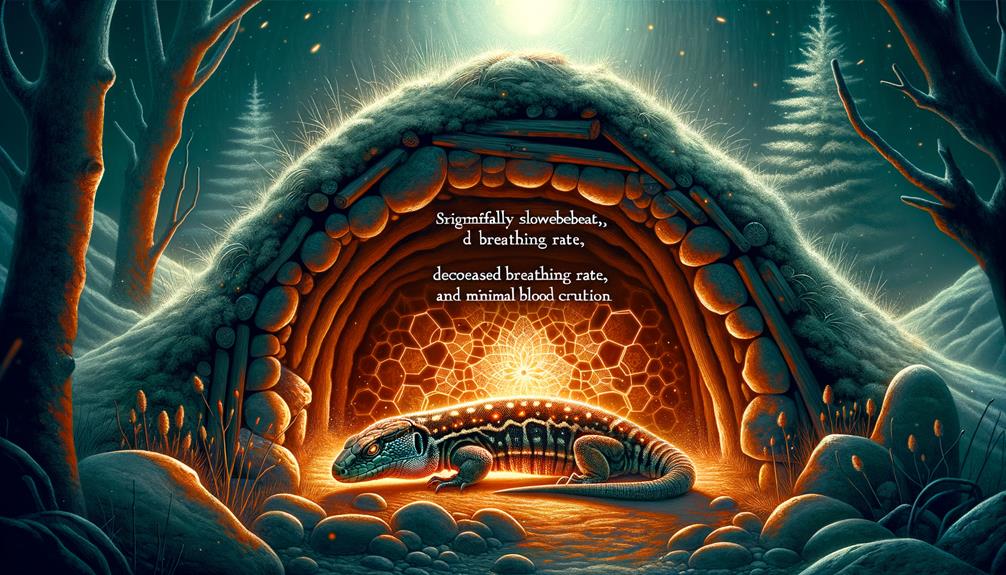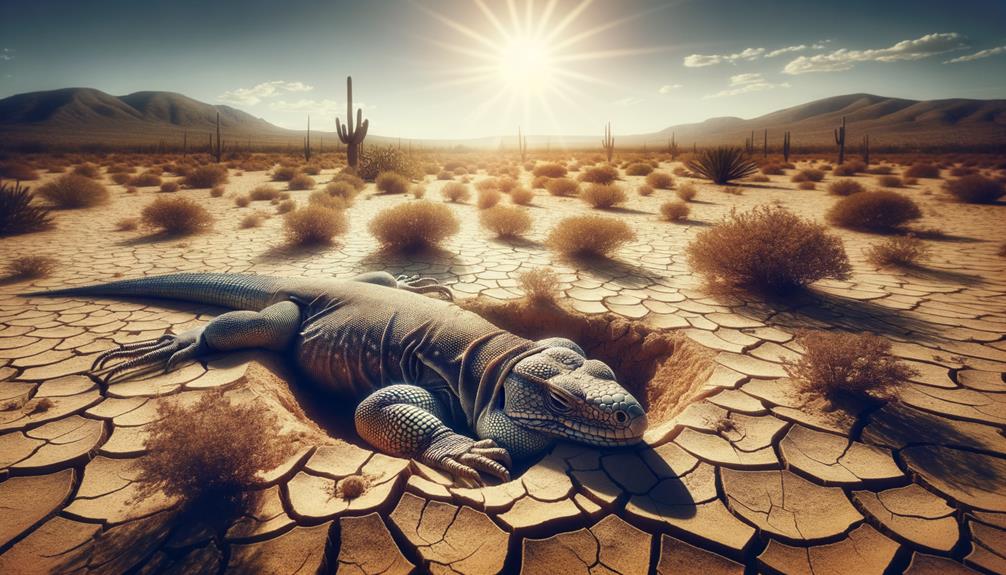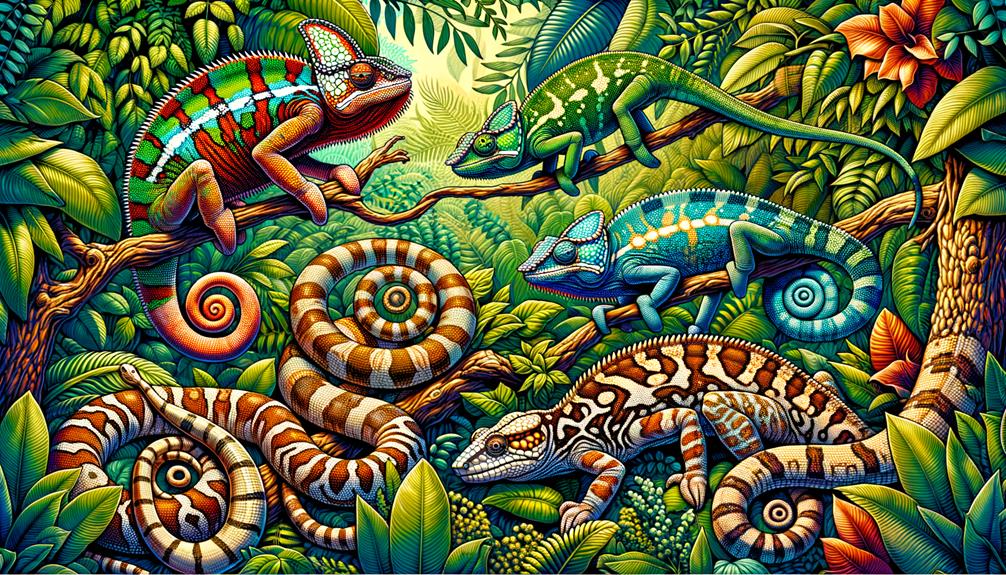Reptiles have always fascinated me with their clever survival strategies, particularly hibernation and aestivation. When winter sets in, they drastically slow down their metabolism and lower their body temperature to conserve energy. This often involves burrowing underground or seeking out insulated shelters. On the other hand, aestivation is their way of coping with hot, dry seasons. They find cooler, moist microhabitats and slow down their metabolic rate, heart rate, and water loss. Each species has its unique triggers and adaptations for these states, such as shorter days, colder temperatures, or extreme heat. If you’re interested in how reptiles thrive in their environment, there’s still much to learn about these remarkable adaptations.
Key Takeaways
Reptiles have adapted to survive extreme weather conditions by developing two unique states: hibernation and aestivation. During hibernation, they conserve energy by reducing their metabolic activity and body temperature to cope with colder months. On the other hand, aestivation allows them to survive hot, dry periods by burrowing and significantly lowering their metabolic and physiological functions.
The trigger for hibernation is a combination of shorter days, colder temperatures, and reduced food availability. Aestivation, on the other hand, is driven by high temperatures, low humidity, and scarcity of food and water. Both states involve a significant reduction in metabolic rate, relying on stored fat reserves for survival.
Understanding Reptile Hibernation
Understanding reptile hibernation, also known as brumation, reveals how these cold-blooded creatures drastically reduce their activity, metabolism, and body temperature to survive the harsh winter months. Since reptiles rely on external heat sources to regulate their body temperature, the drop in ambient temperatures during winter forces them into a state of dormancy. To conserve energy, they enter a period of lowered metabolic activity, greatly reducing their need for food and water.
During brumation, reptiles often burrow underground or seek insulated shelters to protect themselves from the cold. This period of inactivity is vital for their survival, allowing them to minimize energy expenditure when environmental conditions aren’t suitable for normal metabolic functions. As someone who’s passionate about reptiles, I find it fascinating how these creatures can almost ‘shut down’ and endure months of inactivity.
In captivity, it’s vital to replicate these natural conditions carefully to prevent health complications. Each species has unique requirements and hibernation patterns, so it’s crucial to understand their specific needs. By doing so, we can ensure our reptilian companions can safely navigate through their dormant period and emerge healthy and active when warmer temperatures return.
Factors Triggering Hibernation

Several environmental cues trigger reptile hibernation, including shorter days, colder temperatures, and less food. As winter approaches, these changes signal to reptiles like garter snakes that it’s time to prepare for hibernation, a crucial response for their survival.
To get ready, reptiles make significant physiological changes. They slow down their metabolism and lower their body temperature, conserving energy when food is scarce. Let’s take a closer look at the key factors:
- Shorter Days: As fall arrives, the decreasing daylight hours serve as a signal for many reptiles to start preparing for hibernation.
- Colder Temperatures: The drop in temperature is a strong cue, prompting species to find sheltered hibernation sites like burrows or crevices.
- Less Food: As winter draws near, food becomes harder to find, making it vital for reptiles to enter a state where they can survive without regular meals.
Reptile Aestivation Explained

During scorching and arid seasons, reptiles like desert tortoises enter a state of aestivation, drastically slowing their metabolism to conserve energy and water. This adaptation allows them to survive the hot and dry periods that would otherwise be devastating. By lowering their metabolic rate and body temperature, these reptiles minimize water loss and energy expenditure.
Aestivation isn’t just a simple dormancy. Reptiles undergo significant physiological changes, such as reduced cardiovascular and respiratory functions, coupled with complex hormonal signals. These changes guarantee their body remains in a low-energy state, optimizing their chances of survival.
To escape the harsh conditions, aestivating reptiles often seek out cooler, moist microhabitats like underground burrows or shelters. These refuges provide a stable environment that shields them from extreme temperatures and dehydration.
Key aspects of reptile aestivation include:
| Aspect | Description |
|---|---|
| Metabolism | Slowed down to conserve energy and water |
| Body Temperature | Lowered to reduce heat stress |
| Habitat | Cooler, moist areas like underground burrows |
| Physiological Changes | Reduced cardiovascular and respiratory functions |
| Survival Strategy | Adaptation to endure hot and dry environmental stressors |
In essence, reptiles have developed aestivation as a coping mechanism to survive extreme temperatures and water scarcity. By slowing down their metabolism, reducing their body temperature, and seeking cooler habitats, they can conserve energy and water, ensuring their survival until more favorable conditions return.
Environmental Triggers for Aestivation

As I delve into the environmental triggers for aestivation, it’s clear that temperature and humidity shifts are key, especially in desert habitats. When food and water are scarce, reptiles conserve energy by reducing their metabolic demands to survive these harsh conditions. Seasonal changes and photoperiod variations also signal reptiles to enter aestivation, ensuring their survival during periods of extreme heat and dryness.
Temperature and Humidity Shifts
Seasonal shifts in temperature and humidity are crucial environmental triggers that prompt reptiles to enter a state of dormancy, known as aestivation, to survive harsh and resource-scarce conditions during hot, dry periods. As temperatures soar and humidity levels drop, reptiles seek refuge by burrowing underground, where conditions are more stable, allowing them to conserve energy and minimize water loss. This dormant state enables them to endure until more favorable conditions return.
During aestivation, reptiles undergo significant physiological changes. Their metabolic rates slow down, reducing energy expenditure. They maintain lower body temperatures to conserve energy and reduce their water requirements. These adaptations are vital for survival in environments where food and water become scarce during extreme heat. For example, desert tortoises and certain lizards enter a state of dormancy when temperatures rise and rainfall dissipates. They remain in this state until the seasonal conditions shift, signaled by increased humidity and the return of rains. This intricate dance with nature ensures they can thrive even in the most unforgiving climates, demonstrating life’s remarkable resilience and adaptability.
Food and Water Scarcity
When food and water become scarce in harsh environments, reptiles have developed an ingenious way to survive: they enter a state of dormancy called aestivation. This remarkable adaptation allows them to conserve precious resources and contend with the scarcity of food and lack of water that can be deadly in unforgiving climates.
In extreme heat and aridity, reptiles like desert tortoises dig underground burrows to escape the parched surface. Once there, they slow down their metabolism, reducing their energy and water needs. It’s fascinating to see how they can adjust their body temperature and activity levels to minimize water loss and energy expenditure when both are in short supply.
By entering aestivation, these reptiles can buy time until environmental conditions improve. With reduced metabolic demands, they can survive longer without needing to hunt for scarce food or search for elusive water sources. This state of dormancy is a finely tuned response to high temperatures and lack of water availability, allowing them to survive against the odds.
Reptiles’ ability to adapt to harsh conditions is a testament to nature’s ingenuity, showcasing how life can thrive even in the most inhospitable environments.
Seasonal Behavior Patterns
Understanding how reptiles respond to environmental cues reveals their intricate seasonal behavior patterns that trigger aestivation. Aestivation, similar to hibernation, occurs when reptiles encounter extreme heat and arid conditions, compelling them to conserve water and energy. Three main environmental factors drive the onset of this summer dormancy:
High temperatures cause reptiles’ metabolic rates to surge unless they enter a state of torpor.
Low humidity increases water loss, forcing reptiles to find moist microhabitats to prevent dehydration.
Declining food availability pushes reptiles to reduce their energy expenditure to survive.
During aestivation, reptiles enter a state of torpor, significantly reducing their metabolic rate and body temperature to match their environment. They seek out sheltered and moist microhabitats, like underground burrows or rock crevices, to minimize water loss. The duration and intensity of aestivation vary among species, influenced by factors such as body size, geographic location, and specific evolutionary adaptations. By grasping these triggers, we gain insight into the remarkable flexibility and resilience of reptiles in adapting to their ever-changing environments, highlighting their capacity for survival under extreme conditions.
Physiological Changes in Hibernation

Reptiles undergo significant physiological changes during hibernation to survive extended periods of low temperatures and scarce resources. One of the most striking changes is the dramatic reduction in metabolic rate, which allows them to conserve energy. Since they don’t consume food and water during this period, they rely on stored fat reserves to sustain themselves.
Their body temperature can drop to just a few degrees above the ambient environment, minimizing energy expenditure. This decrease in temperature is accompanied by a significant slowing of the heart rate, sometimes to just a few beats per minute. Breathing becomes infrequent, with some reptiles taking only a few breaths per hour. This near-comatose state is an effective strategy to preserve energy in the face of limited resources.
Digestive processes come to a halt, as there’s no intake of food and water. These physiological adjustments guarantee that their energy reserves last throughout the hibernation period. However, the suppression of immune function makes them more vulnerable to diseases, highlighting the importance of a well-prepared habitat. These adaptations showcase the incredible resilience of reptiles in the face of harsh environmental conditions.
Adaptations for Aestivation

When I delve into the fascinating world of reptile aestivation, I’m struck by their resourceful adaptations for survival. These reptiles have developed clever techniques to conserve water, such as producing waxy coatings and burrowing into cooler environments. They also drastically slow down their metabolic rates, allowing them to withstand extended periods of extreme heat and dryness with minimal energy expenditure.
Water Conservation Techniques
Desert tortoises have developed remarkable water-saving adaptations to survive the scorching summer months. They enter a state of dormancy called aestivation, which is different from hibernation, as it’s specifically designed to conserve water in extreme heat.
To survive in the harsh desert environment, desert tortoises have developed several strategies:
- Burrowing: They dig deep into the ground, where temperatures are cooler and humidity is higher, creating a microenvironment that helps prevent water loss.
- Shell Sealing: Like desert snails, tortoises can retract into their shells, reducing the surface area exposed to the air and minimizing evaporation.
- Metabolic Adjustment: By slowing down their metabolism, they reduce their need for water and food, allowing them to survive on their stored body reserves.
Other species have also evolved unique techniques to conserve water. For example, African bullfrogs encase themselves in a mucus cocoon, while desert snails seal their shells with a papery epiphragm. These adaptations are a testament to nature’s resourcefulness, enabling life to thrive even in the most challenging conditions.
Metabolic Rate Reduction
In addition to their remarkable water-saving techniques, aestivating reptiles employ an incredible strategy to survive: they drastically reduce their metabolic rate. This can drop by as much as 90% compared to when they’re active. As they enter this deep sleep state, their body temperature often mirrors the ambient conditions, which helps conserve energy during the harshest, driest periods.
Their heart rate and respiratory rate also slow down, minimizing energy expenditure. Hormonal changes, particularly the reduction of thyroid and adrenal activity, play a key role in initiating and maintaining this dormant state. These changes allow reptiles to enter and sustain a profound metabolic depression, ensuring they don’t deplete their limited energy reserves.
Some aestivating reptiles take it a step further by producing a water-impermeable cocoon or burrowing underground to reduce evaporative water loss. These adaptations are crucial for their survival. By understanding these mechanisms, we gain insight into the extraordinary lengths these reptiles go to thrive in their challenging environments, demonstrating an impressive ability to endure the extremes of nature.
Frequently Asked Questions
What Is the Difference Between Aestivation and Hibernation?
Think of aestivation as a summer break and hibernation as a winter rest. Aestivation helps animals cope with hot and dry conditions, while hibernation helps them survive cold temperatures and food scarcity. Both reduce metabolic rates, but they’re triggered by different factors and last for different lengths of time.
Do Lizards Hibernate or Aestivate?
Lizards have adapted to survive in various environments by developing two distinct strategies: brumation and aestivation. During cooler months, they enter a state of dormancy, similar to hibernation, known as brumation. In extreme heat, they conserve energy and water by aestivating, ensuring their survival.
What Is Reptile Aestivation?
Aestivation is a fascinating survival tactic that reptiles use to cope with hot, dry spells. When temperatures soar, they burrow underground, drastically slowing down their metabolism and lowering their body temperature to conserve energy and water. This state of dormancy helps them survive until the environment becomes more hospitable.
What Is the Reptile Version of Hibernation?
Imagine a bear curling up for winter – well, reptiles have a similar strategy called brumation. They slow down their metabolism and heart rate, conserving energy during the cold months to ensure they survive until warmer days return.



